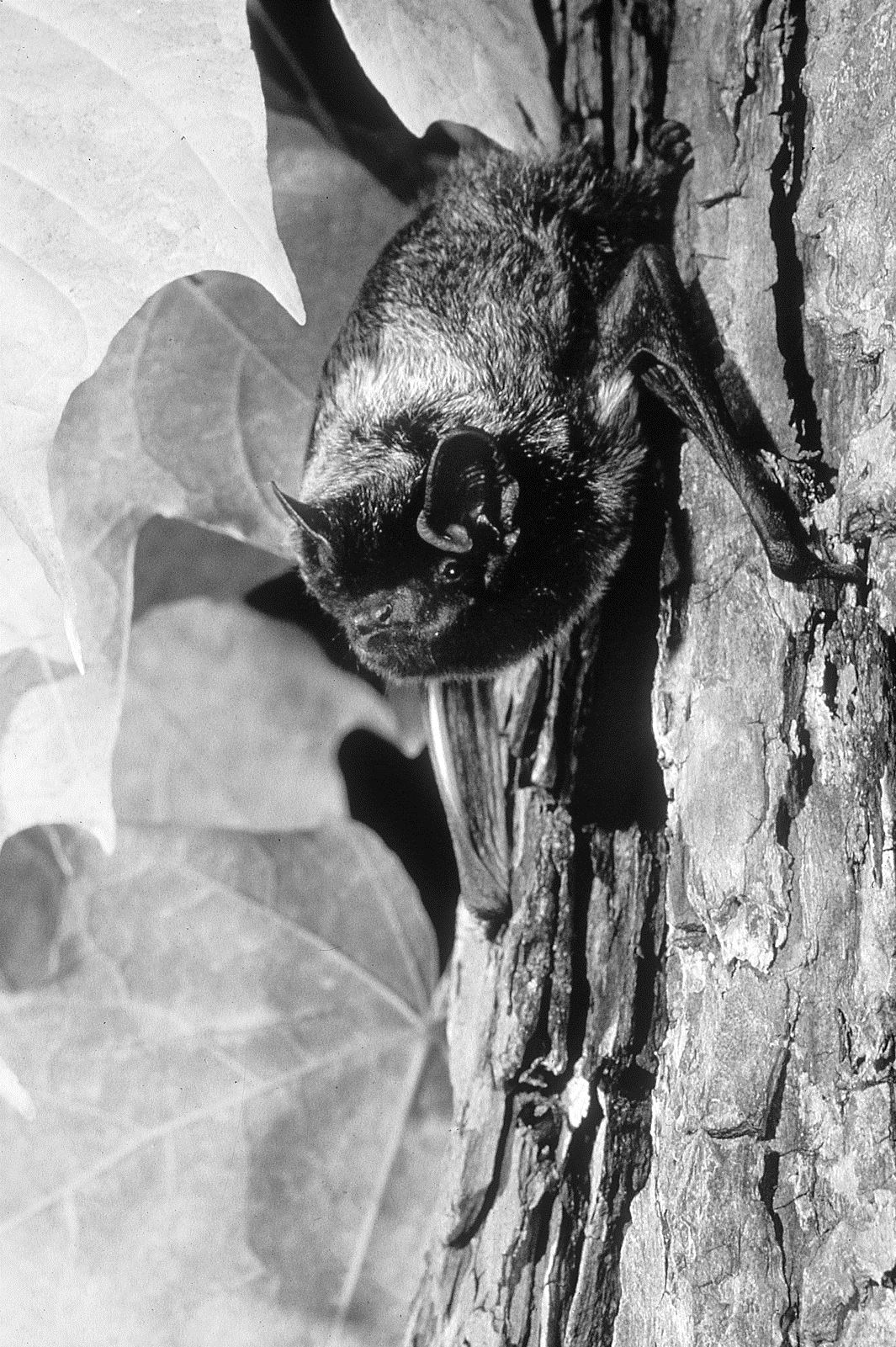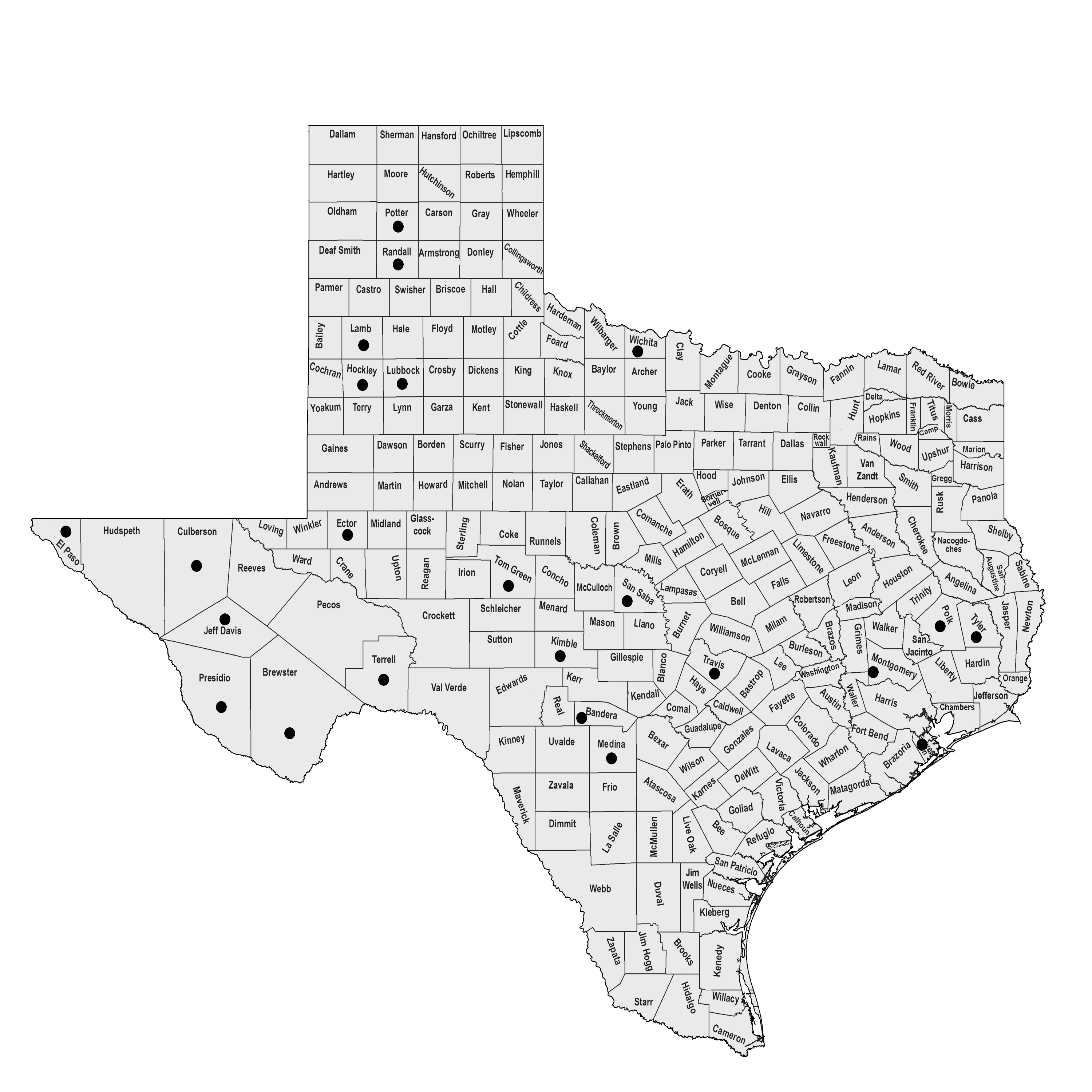SILVER-HAIRED BAT
Lasionycteris noctivagans Le Conte 1831
Order Chiroptera : Family Vespertilionidae
DESCRIPTION. A medium-sized, nearly black bat with dorsal surface of interfemoral membrane densely furred at least on the basal half and usually to near margins; upper and lower parts sooty brown or black with white tips of hairs producing a frosted appearance; membranes and ears sooty brown or black. Dental formula: I 2/3, C 1/1, Pm 2/3, M 3/3 × 2 = 36 (upper incisors and first lower premolar very small and easily overlooked). Averages for external measurements: total length, 100 mm; tail, 40 mm; hind foot, 8 mm; ear, 16 mm; forearm, 41 mm. Weight, 8–12 g.

DISTRIBUTION. Broadly but erratically distributed across northern North America; recorded from 29 widely distributed counties in six physiographic regions of Texas (Pineywoods, Gulf Prairies and Marshes, Edwards Plateau, Rolling Plains, High Plains, and Trans-Pecos). The species is apparently a fall–spring migrant. These bats are denizens of forested areas and seldom are observed in xeric areas except in migration. Except for the Guadalupe Mountains in the Trans-Pecos, midsummer records do not exist for Texas. Interestingly, there are no confirmed records from the South Texas Rio Grande Plains.

SUBSPECIES. Monotypic species.
HABITS. Cavities in trees and spaces under loose bark are favorite daytime retreats, but these bats may also use buildings. This species is migratory, at least in part. It spends the summer in northern latitudes and winters toward the south, even crossing several hundred kilometers of ocean to reach Bermuda. Surprisingly few winter records are available; thus, the mystery of just where these bats spend the winter is still not completely solved. It is likely that many of them winter on their breeding grounds because occasional individuals have been found hibernating as far north as New York and British Columbia. Interestingly, most summer records of this bat across the Southwest are of males, suggesting that geographical segregation of the sexes may occur during the warmer months. Females appear to move north in spring and summer to bear young, whereas the males remain behind at more southern locales.
This bat typically forages in or near coniferous or mixed deciduous forests adjacent to ponds or other sources of water. It is a relatively late flier that often appears after other bats have begun feeding. As with most other insectivorous bats, Lasionycteris noctivagans is opportunistic in its feeding habits and takes a wide variety of small to medium-sized insects. The diet consists mostly of moths, with beetles, leafhoppers, true bugs, midges, flying ants and termites, and small flies also taken. Mating presumably occurs during autumn, when the bats are migrating, and females presumably store sperm in their reproductive tracts over the winter. Following a gestation period of 50–60 days, twins are born in June or July. Small maternity colonies may form in hollow trees and abandoned bird nests. The young are black and wrinkled at birth and are able to fly when about 3 weeks old.
POPULATION STATUS. Uncommon, fall–spring migrant. The silver-haired bat, although widely distributed across Texas, is not commonly found in specimen collections or encountered in large numbers.
CONSERVATION STATUS. The IUCN status of the silver-haired bat is least concern because of its wide distribution, presumed large population, occurrence in protected areas, tolerance to some degree of habitat modification, and the likelihood that it is not declining at a rate sufficient to require inclusion in a threatened category. Although there do not appear to be any immediate threats to its status, in the future wind turbine facilities could prove to be a problem. Although no data are available for Texas, L. noctivagans is one of the three bats with the highest fatality rates at such facilities in the United States. As the number of wind-energy facilities continues to grow in Texas, it will be important to monitor the impact on migratory bat species such as L. noctivagans.
From The Mammals of Texas, Seventh Edition by David J. Schmidly and Robert D. Bradley, copyright © 1994, 2004, 2016. Courtesy of the University of Texas Press.
Natural Science Research Laboratory
-
Address
Museum of Texas Tech University, 3301 4th street, Lubbock, TX 79409 -
Phone
806.742.2486 -
Email
nsrl.museum@ttu.edu

